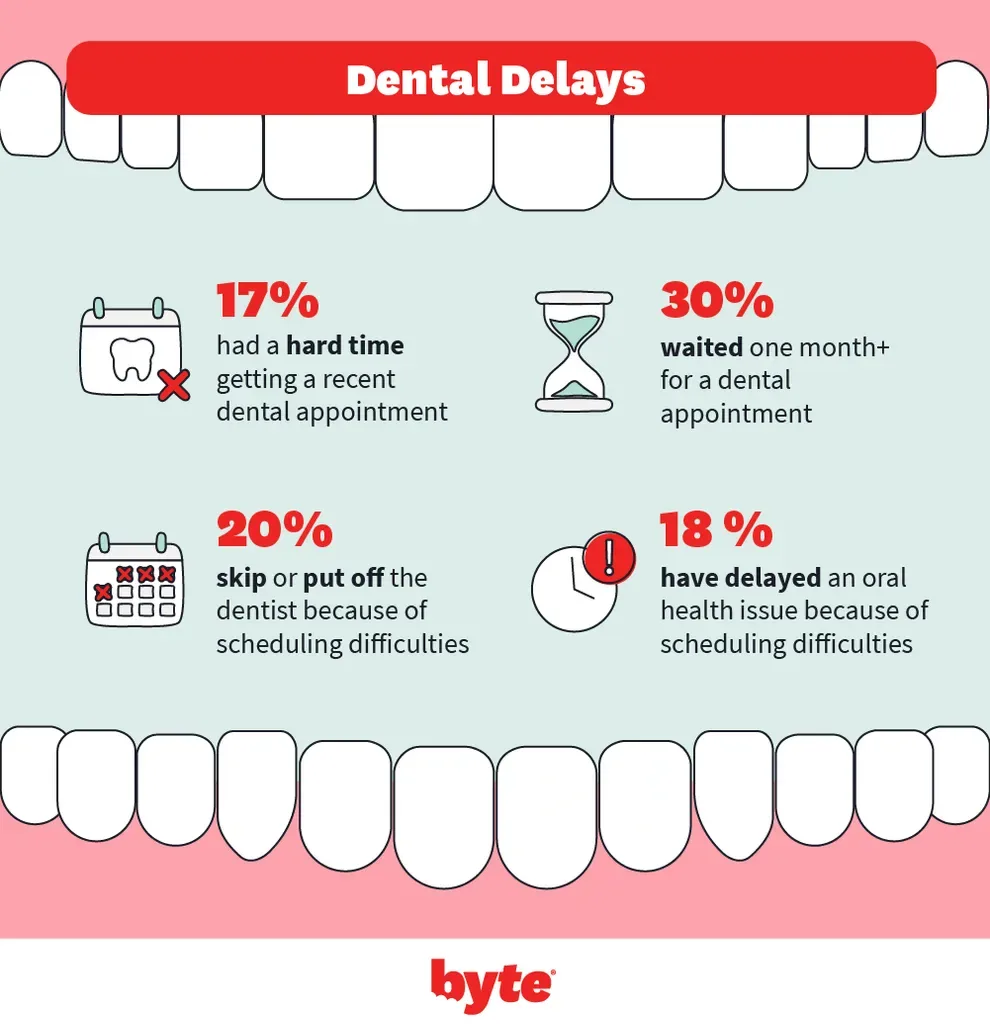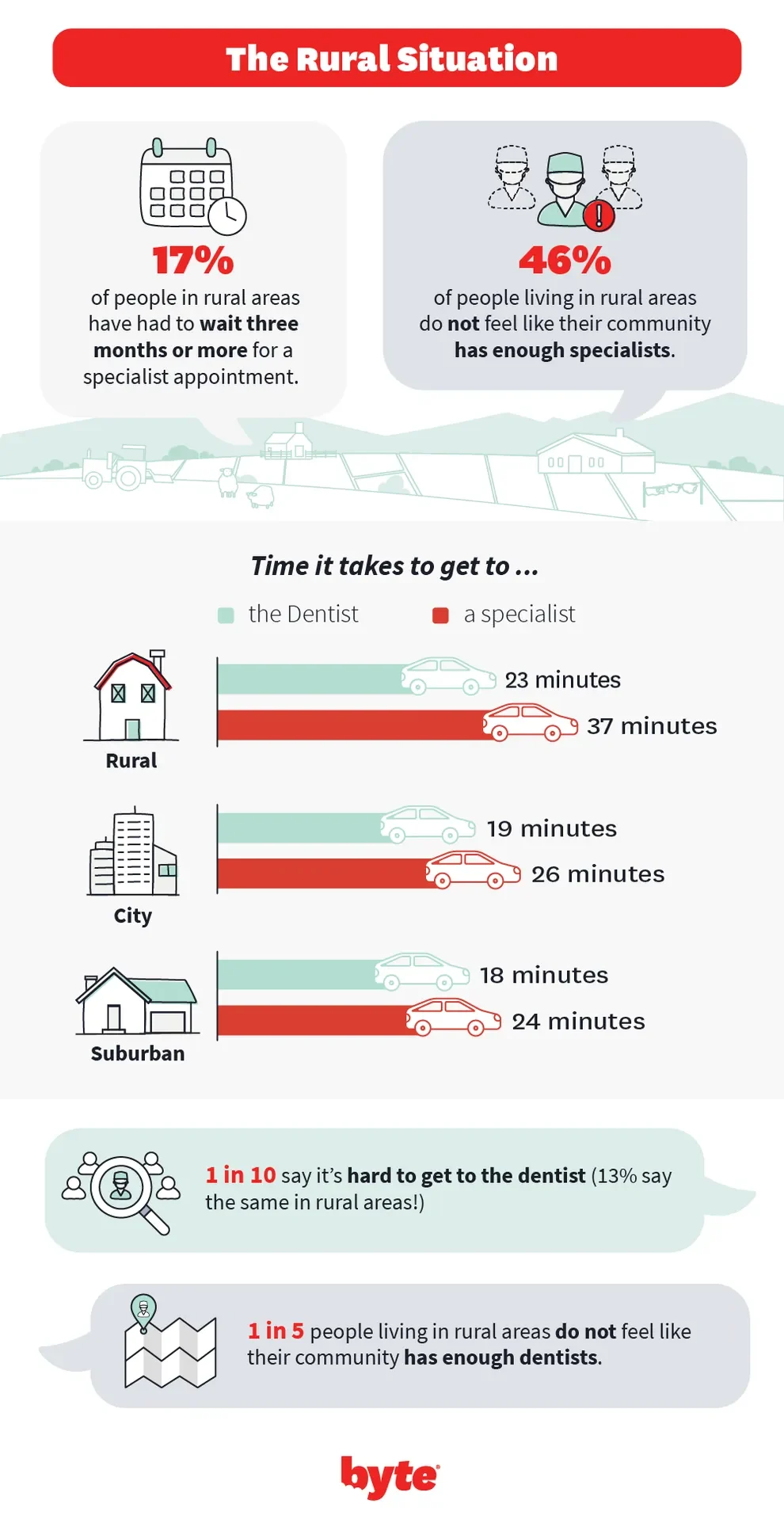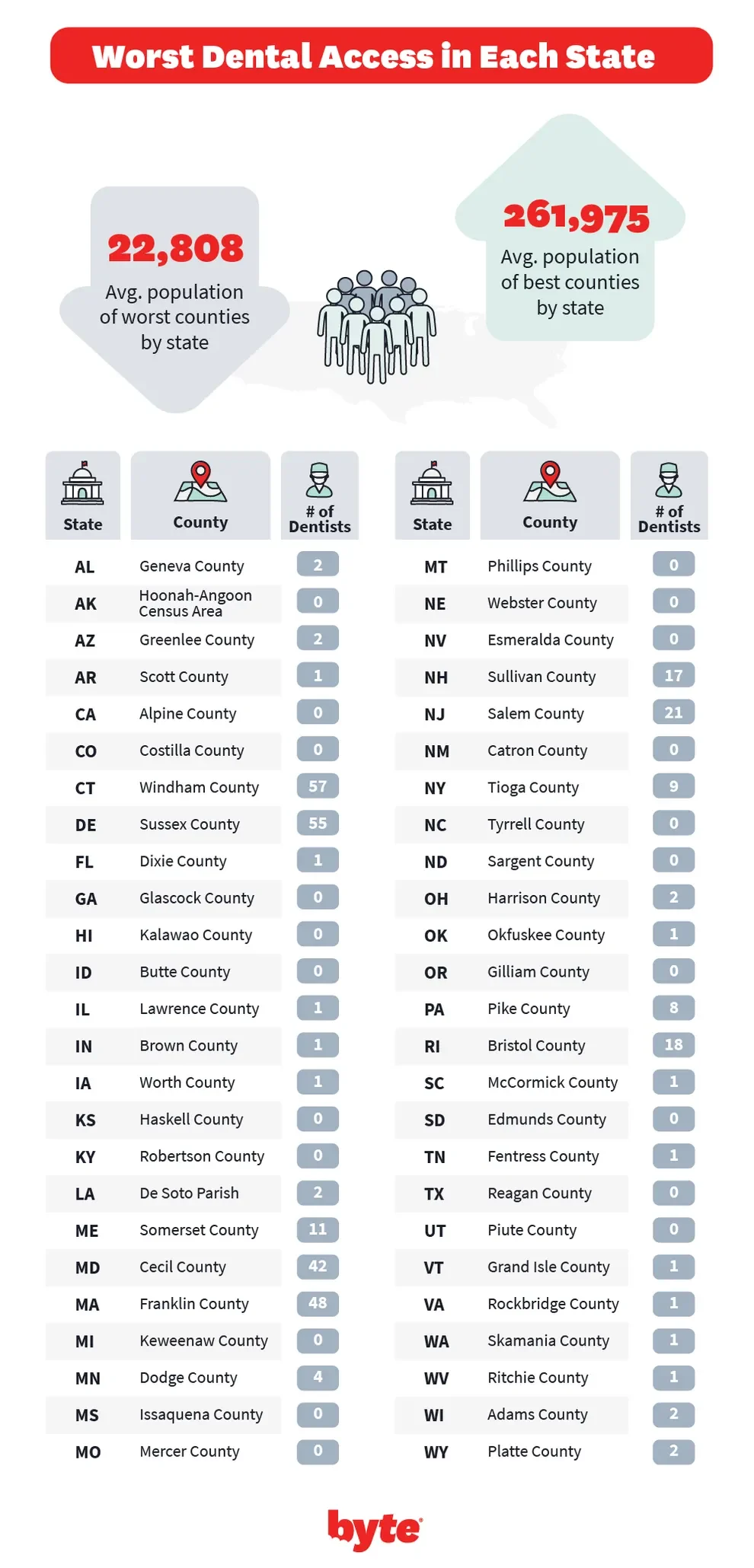Dental Deserts: Rural Areas Struggling With Lack of Dental Care in the U.S.
Table of Contents
- Patient-to-Dentist Ratio by County
- Dental Appointment Delays
- Dental Access by State
- The Rural Health Disparity
- Worst Dental Access in Each State
- Methodology
- Fair Use
The Centers for Disease Control recommends you go to the dentist at least once a year1, but 1 out of 4 people we surveyed say they haven’t been since 2019 or earlier. This doesn’t necessarily have to do with the pandemic or even cost. We found 1 out of 3 people do not go regularly to the dentist at all, and that number is even higher in rural communities.
Here at Byte we examined county-by-county data across the U.S. to see which regions are struggling the most with dental care access. We also surveyed more than 1,000 people about their oral health and found people living in rural areas are having to put in a lot of extra mileage just to get the care they need.
Patient-to-Dentist Ratio by County
In the United States, the average patient-to-dentist ratio in 2020 is 1399:12, but across the nation some areas have one dentist for every 20,000+ people or none at all. The areas with some of the worst access lie in the South.
Of the counties that have dentists, the top 10 worst counties are in: Georgia, Texas, Virginia, Mississippi, and Tennessee. In Madison County, Georgia there is only 1 dentist for every 30,460 people3. That means just one dentist is serving every single person who lives in the county.
But some counties don’t have any dentists to choose from. Counties in Colorado, Kansas, and Montana have the worst ratio in the nation: 3,920 people with no dentist (3920:0).
Dental Appointment Delays

According to our survey, nearly 1 out of 5 (17%) Americans have been having a hard time getting a recent dental appointment. Nearly 1 out of 3 (30%) have waited more than a month for a dental appointment.
Scheduling difficulties ended up causing 20% of people to put off or even skip the dentist. Of those surveyed, nearly 1 out of 5 (18%) admitted to delaying an oral health issue because of scheduling difficulties.
Dental Access by State

Across the U.S., some of the best states with dental access are: Massachusetts, New Jersey, Connecticut, California, and New York. Massachusetts has one dentist for every 1,048 people. The average patient-to-dentist ratio in the U.S. from 2010-2020 is 1538:1.
The top five worst states are: Arkansas, Mississippi, Alabama, Delaware, and Georgia. All five states have an average of one dentist for more than 2,000 people. The state of Arkansas has the worst ratio with just one dentist for every 2,280 people in the state4.
The Rural Health Disparity

Transportation to the dentist can be a challenge, with 1 in 10 saying it's hard to physically get there. It’s not cheap either. In June 2022, gas prices reached an all-time high of $5.06 per gallon5. Although people living in the cities and suburbs sometimes struggle with dental access, the biggest health disparity lies in rural communities.
It takes people living in rural communities an average of 23 minutes to get to the dentist compared to 19 minutes for people in cities and 18 minutes for those in the suburbs. Additionally, 1 out of 5 people living in rural areas do not feel like their community has enough dentists.
When it comes to specialists, such as orthodontists and oral surgeons, that concern is even higher. Nearly 1 out of 5 (17%) people in rural areas have had to wait three months or more for a specialist appointment.
It takes people in rural communities an average 37 minutes to get to a specialist! That’s a lot more than it takes people living in the city (26 minutes) and the suburbs (24 minutes). Nearly half (46%) of people living in rural areas do not feel like their community has enough specialists, which is why many often turn to online services like teledentistry.
Worst Dental Access

The disparity is especially noticeable when examining the population of the best and worst counties by state. The average population of the worst county in each state is 22,808. Compare that to the average population of the best county in each state: 261,975.
The worst counties in nearly half of the U.S. have no dentists at all. 21 states have zero dentists available for the entire county. 12 states only have one.
The Centers for Disease Control reports more than 1 out of 4 (26%) adults have untreated cavities6, which is painful and can lead to even more serious health problems. The CDC says untreated oral disease causes the U.S. to lose $45 billion yearly7. Consistent dental care is vital to creating a healthier community and avoiding bigger health issues in the long run. If you or someone you know is interested in becoming a dentist, it pays well. The average dentist makes $180,830 a year.
Methodology
In June 2022, we surveyed 1,107 people to get their feedback on the dentist. Survey respondents ranged in age from 18 to 83. The average age of respondents was 39. 49% were female, 48% male, 2% were nonbinary, and 1% were transgender. 55% said they live in the suburbs, 29% in the city, and 16% in rural areas.
We also analyzed the patient-to-dentist ratio using data from County Health Rankings & Roadmap (a collaboration between the Robert Wood Johnson Foundation and the University of Wisconsin Population Health Institute).
For media inquiries, please contact media@digitalthirdcoast.net.
Fair Use
When using this data and research, please attribute by linking to this study and citing Byte.com
